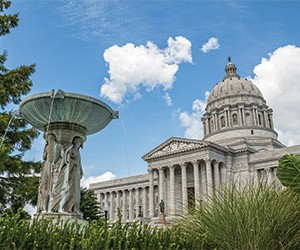Central Missouri has been at the crossroads throughout American history. The region’s past, including the Lewis and Clark Expedition, the Civil War era and the building of the Bagnell Dam, has been preserved through many of the area’s off-site venues.
Boone County Historical Society and Historic Nifong Park, Columbia
The Boone County Historical Society operates Walters Boone County Museum along with the Montminy Art Gallery, the Maplewood House and the Village at Boone Junction, all in Columbia’s Nifong Park.
The Walters Boone County Museum houses artifacts and records of the people of Boone County in two exhibit halls and display rooms. There is also 10,000 square feet of vaults and storage space for the collections and preservation of pieces of historical significance to the region. The Maplewood House was built in 1877 for a Boone County pioneer family, and the 430-acre farm originally included a pond and additional buildings for servants, a carriage house and a barn. In 1970, the City of Columbia purchased the land, which is now historic Nifong Park.
Groups can book the different venues, including the 4,000-square-foot Montminy Art Gallery, which features rotating exhibits. There is a conference room equipped with a board table and chairs, the first floor of the Maplewood home, and for outdoor events, a covered veranda and gazebo offer views of the park.
J.W. Blind Boone House, Columbia
In the late 1800s John Lange Jr., built a two-story Victorian house in Columbia that was then home to musician John W. “Blind” Boone. Boone is known for his work as a composer and concert pianist blending African-American folk with European classical music, influencing ragtime, jazz and boogie-woogie, all while facing adversities such as blindness and poverty.
Originally the home was small and featured wooden weatherboarding and a two-story front porch. Over the years, the home was upgraded and additions were made, changing the original Victorian appearance, but the interior, with original woodwork, fireplace and curved staircase, was kept intact. In 1996, the home was restored as a remembrance of Boone, his works and importance to the community.
Planners can arrange for group tours of the home or host receptions in the historic home.
The Millbottom, Jefferson City
The Millbottom, once a power plant, was restored and renovated into an event center. The building dates to the early 1900s when it operated as a gas plant for Ameren and as a power plant for both the Missouri Power and Light Company, and before that for Jefferson City Light, Heat and Power Company.
“The building is named after the area in which it was originally located, the Mill Bottom,” said Margaret Oberkrom, assistant manager of The Millbottom. “The area got this name because it was the area in the river bottom where farmers would bring their grain from all over to be milled.”
Today, the event center has an indoor capacity of 300 people with the ability to expand to 1,200 people for an indoor/outdoor event. The main room, that once held the plant’s boilers, is a 4,700-square-foot space with large arched windows and exposed steel beams that are original to the building. The venue also features a caterer’s kitchen with commercial equipment, an indoor/outdoor bar and a mezzanine level that can also be used for functions.
PageBreak“Since its opening, we’ve hosted all kinds of events, from fundraisers, concerts, weddings, corporate trainings, car shows, and in fall of 2017 we’re excited to host our first craft show,” Oberkrom said. “One really cool thing is that during the renovations they found some steel that had U.S. Steele imprinted on it.
“We are the only space like this in Jefferson City with the soaring ceilings, exposed brick, original metal beams, natural light, stunning views of the Capitol and capability to be indoor/outdoor,” she said.
The Colonel Bolton Home, Jefferson City
Built in 1833 for Col. Bolton, the first warden of the nearby Missouri State Penitentiary, and overlooking the Osage River, the pre-Civil War antebellum home features stone from the river’s bluff on the exterior. The historic site is now a bed and breakfast with three guest rooms and a space for meetings and events. Inside the home, groups of up to 48 can use the dining room and parlor rooms along with the residential kitchen.
“We have hosted everything from retreats to business meetings to dinner parties,” said Mary Markway, whose husband’s great-grandparents were the second owners of the home in the late 1800s. “Groups can also partake in a tour of the home where we talk about the history of each room and interesting tidbits about the home, like how some of the windows were built at an angle to let more natural light in.”
For groups of up to 150 there is the event center that includes an 1,800-square-foot room and the full use of the grounds.
Camden County Museum, Lake of the Ozarks
The Camden County Museum was originally a schoolhouse constructed when the town of Linn Creek had to be relocated due to the building of the Bagnell Dam in the late 1920s. The building now houses artifacts from the towns of the county, such as tools, furniture, firearms and Civil War memorabilia. There are also exhibits showcasing historic journals and publications on display, and genealogy services for those who might have roots in Camden County.
“We have a lot of artifacts and photos on the history before the dam and since the dam,” said Daphne Jeffries, president of the Camden County Museum & Historical Society. “We have a rich history, especially with the amount of people that have come through the area.”
The museum offers both self-guided and group tours and is available to host private events for 100 guests.
Willmore Lodge, Lake of the Ozarks
The Willmore Lodge is a log building that was built in 1930 for Union Electric, which oversaw the construction of Bagnell Dam. The lodge was designed by Louis La Beaume, a noted St. Louis architect, who also worked on the Louisiana Purchase Exposition and was a member of the St. Louis City Planning Commission and president of the St. Louis Art Museum. The lodge houses 29 rooms and was constructed with Western white pine logs brought by train from the Pacific Northwest of the U.S.
In 1945, Union Electric sold the building to Cyrus Crane Willmore, a St. Louis real estate developer, who foresaw the area becoming a popular vacation destination with the creation of a new manmade lake.
Although sold since, the building has kept the Willmore Lodge name and was reacquired by Union Electric in 1996 to insure it, as well as the surrounding land, would be protected as a National Historic Site.
Today, the lodge is home to the Lake Area Chamber of Commerce and the Bagnell Dam History museum and is available for private rental.
The lakefront property can host events for up to 80, utilizing space inside the lodge, in the gardens and on the waterfront, including the gazebo that overlooks the lake.







